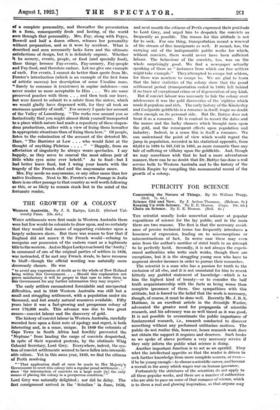PUBLICITY FOR SCIENCE
Tax scientist usually looks somewhat askance at popular expositions of science for the lay public, and in the main there are two reasons. The first is that the necessary avoid- ance of precise technical terms too frequently introduces a looseness of expression, leading on to misconceptions or misconstructions of fact. In worse case these may even arise from the author's sacrifice of strict truth in an attempt to be perfectly lucid. Secondly, it is not always the experi- enced authorities who write such works, though there are exceptions, but it is the struggling young men who have to augment slender incomes in order to pursue their researches.
The scientist is a man who has a passion for truth to the exclusion of all else, and it is not unnatural for him to resent bitterly any garbled statement of knowledge—which is to him the highest kind of beauty—or to consider the half truth acquaintanceship with the facts as being worse than complete ignorance of them. One sympathizes with this attitude, but is forced to the belief that the work is necessary, though, of course, it must be done well. Recently Mr. J. B. S. Haldane, in an excellent article in the Scientific Worker, advocated the greater need for propaganda of scientific research, and his advocacy was as well timed as it was good. It is not possible to overestimate the public importance of fundamental research, i.e., research conducted to discover something without any preformed utilitarian motives. The public do not realize this, however, hence research work does not obtain the support it requires and deserves. Such books as we spoke of above perform a very necessary service if they only inform the public what science is doing.
Another important function is to act as an aperitif. They whet the intellectual appetite so that the reader is driven to seek further knowledge from more complete sources, or even— if he be young enough—to choose a scientific career, and become a recruit in the army which wages war on human ignorance.
Fortunately the strictures of the scientists do not apply to all these popular works, and there are a number of authorities who are able to pass on some of that romance of science, which is to them a real and glowing inspiration, so that anyone may
appreciate its fascination. Such a one is Sir William Bragg, whose researches on crystal structure are already classic. At the Royal Institution, of which he is Director, he delivered a series of popular lectures on "The Nature of Things," which are now published in book form. From them we see how the poetic and scientific spirit are still wedded, as they were in the time of Lucretius, for Sir William has a deep appreciation of the innate beauty of the fundamental structure of things, and he is able to infuse not a little of it to his readers. His lectures were amplified with experiments, and their place is taken here by fine illustrations. Most people are interested to know something about the stuff things are made of, and these lectures on gases, liquids, and crystals will set them a good way on the path and moreover will convince them of the beauty of the scenery.
Professor J. Arthur Thomson needs no introduction to the public which he has delighted by his voluminous contri- butions to their edification, but his field is a different one. Animate Nature claims his attention and affection, one might rightly say his love, for Science Old and New is suffused with the fascination of Natural History. There are fifty-two studies, some of which are reprinted from the popular Press, on a wide range of biological subjects, from fire-flies to the human hand, and from dancing mice to the story of how the elephant got his trunk—which differs materially, however, from Kipling's version. The author finds most scope in dealing with his own observations of bird life, which are veritable little idylls ; a discursive and readable volume this.
Professor Slosson is not, perhaps, so well known on this side of the Atlantic as on the other (he is Director of Science Service at Washington), but the two works mentioned above should do much to change this, for he combines a spacious
acquaintanceship with the sciences with a highly-developed journalistic instinct. Between these two volumes he deals with over two hundred diverse subjects culled from all branches of recent scientific progress—palaeography, photography, physics, physiology, protozoology, psychology—to choose, only those beginning with "p," for to do more would require the complete index. These short " Chats " have mostly appeared in American magazines ; and they bear the stamp of their origin in the use of a vividness of idiom we do not usually -find in such works on this side. It is difficult to imagine a British scientist entitling even the most popular article on the falling of a cat as "Why Kitty Lands Butter- Side Up," or an article on the rust fungus as "Returned Forest Emigrant Threatens Pantry." But the books do not really lose by this, the unexpected voila of expression is quite refreshing. One must mention, too, the article on Einstein in words of one syllable as being particularly good. These are two excellent books to give one's nephew, and dip into first oneself.
W. P. K.







































 Previous page
Previous page